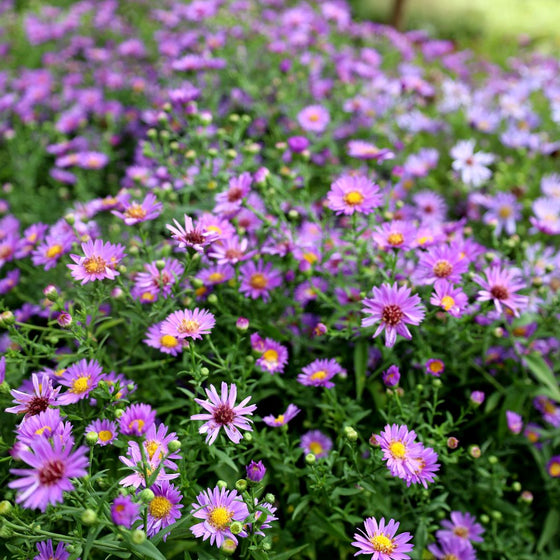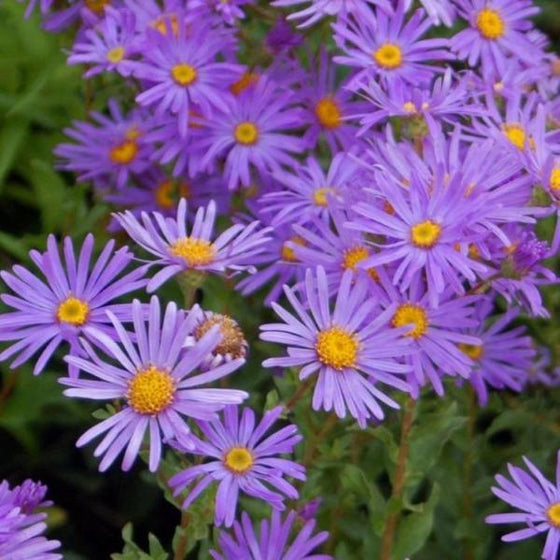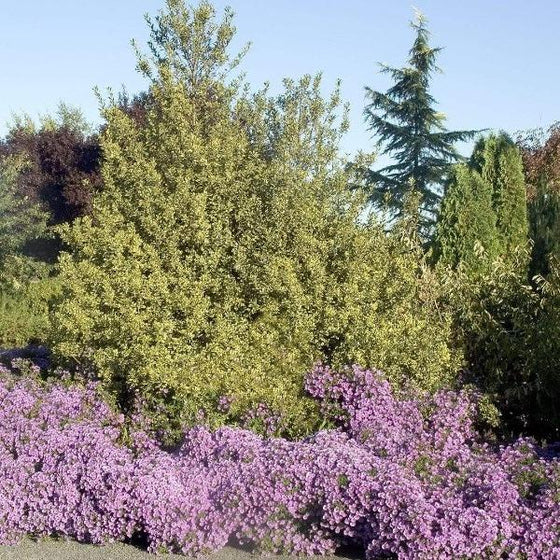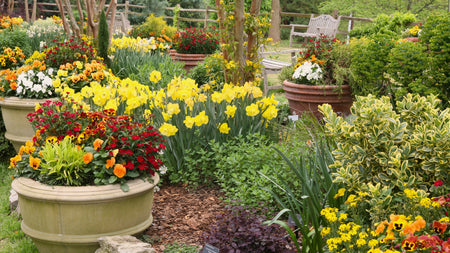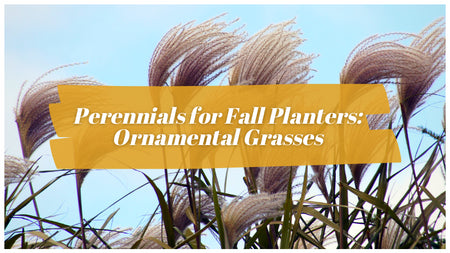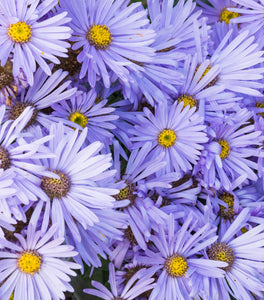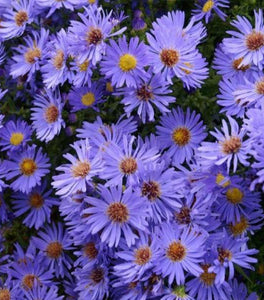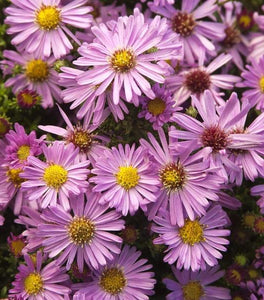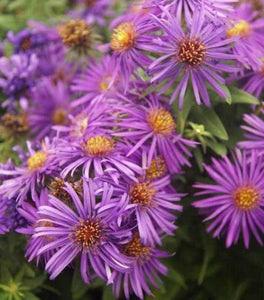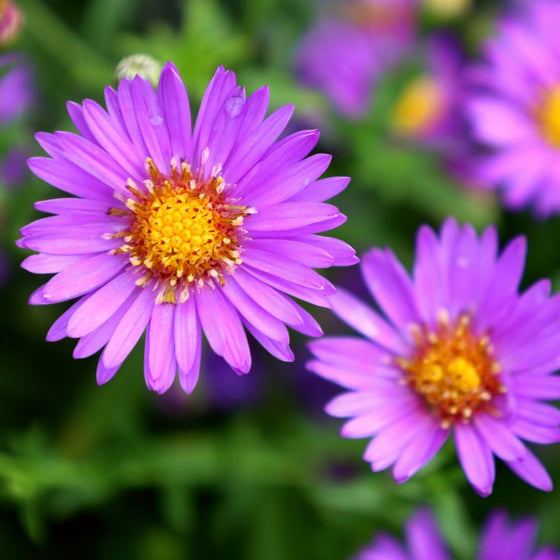
Images Depict Mature Plants
Compact Fall-Blooming Aster with Vivid Color and Pollinator Power
Brilliant Fall Blooms That Last for Weeks
Aster ‘Wood’s Purple’ lights up the late-season garden with masses of rich violet-purple daisy-like flowers that appear from late summer into fall. These compact perennials provide a vibrant burst of color just when most other blooms are fading, creating an irresistible display that attracts a multitude of butterflies and bees.
Compact Growth Perfect for Borders and Containers
With its tidy, mounded habit, Wood’s Purple Aster stays under 18 inches tall, making it ideal for edging garden paths, fronting mixed borders, or adding long-lasting color to patio planters. Its strong stems resist flopping, ensuring the plant maintains its shape even after heavy rains.
Easy to Grow and Low Maintenance
This hardy perennial thrives in full sun and well-drained soil, tolerating light drought once established. It’s naturally resistant to deer and rabbits, requiring minimal care to perform beautifully year after year. Simply plant it in a sunny spot, and enjoy reliable color and structure every fall.
A Late-Season Essential for Pollinator Gardens
Few perennials rival the pollinator power of Wood’s Purple Aster. Its nectar-rich blooms are a late-season lifeline for bees, butterflies, and other beneficial insects. Pair it with ornamental grasses or fall favorites like Rudbeckia and Sedum for a stunning seasonal display that supports local wildlife.
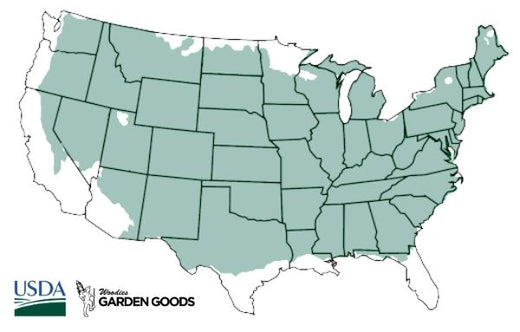
| Hardiness Zone: | 4-8 |
|---|---|
| Mature Height: | 12 to 18 Inches |
| Mature Width: | 18 to 24 Inches |
| Classification: | Perennial |
| Sunlight: | Full Sun |
| Habit: | Upright, clump forming |
| Flower Color: | Violet Purple |
| Flowering Season: | Late Summer to Fall |
| Foliage: | Dark Green |
| Soil Condition: | Well-drained, average garden soil |
| Water Requirements: | Moderate; water weekly until established |
| Uses: | Borders, cottage gardens, containers, pollinator gardens |
How to Care for Aster ‘Wood’s Purple’ (Wood’s Purple Aster)
urpleBe sure to read our planting instructions to ensure a healthy and happy Aster Wood's Pink plant for years to come!
How should I plant Aster ‘Wood’s Purple’?
Select a sunny spot with well-drained soil. Dig a hole twice as wide as the root ball and just as deep. Place the plant so the top of the root ball is level with the surrounding soil, then backfill with native soil mixed with compost for added nutrients. Water thoroughly after planting to remove air pockets and help roots settle. Space plants 18 to 24 inches apart to ensure proper airflow and prevent mildew. Apply a thin layer of mulch to retain moisture and keep weeds down—just keep it off the plant crown to avoid rot.
How often should I water Aster ‘Wood’s Purple’ after planting?
During the first few months, water deeply once or twice per week. Once established, this perennial requires minimal water and can tolerate short dry spells. Consistent moisture during bloom time, however, will result in fuller, longer-lasting color. Check the top inch of soil regularly—if it’s dry, give it a thorough soak. Mulching helps maintain steady soil moisture while keeping roots cool.
When should I fertilize Aster ‘Wood’s Purple’?
Fertilize lightly in early spring with a balanced, slow-release fertilizer or compost to encourage strong growth. Avoid high-nitrogen fertilizers, which can lead to floppy stems and fewer flowers. In midseason, a light top-dressing of organic compost can refresh the soil and support extended blooming. Always water well after feeding to help nutrients reach the roots.

When and how should I prune Aster ‘Wood’s Purple’?
In late spring or early summer, pinch or trim the stems by one-third to encourage bushier growth and more blooms. After flowering, remove spent blooms to maintain a tidy look and encourage reblooming. Cut plants back to just above ground level in late fall or early spring. This rejuvenation promotes fresh, vigorous growth each year and helps prevent disease.

